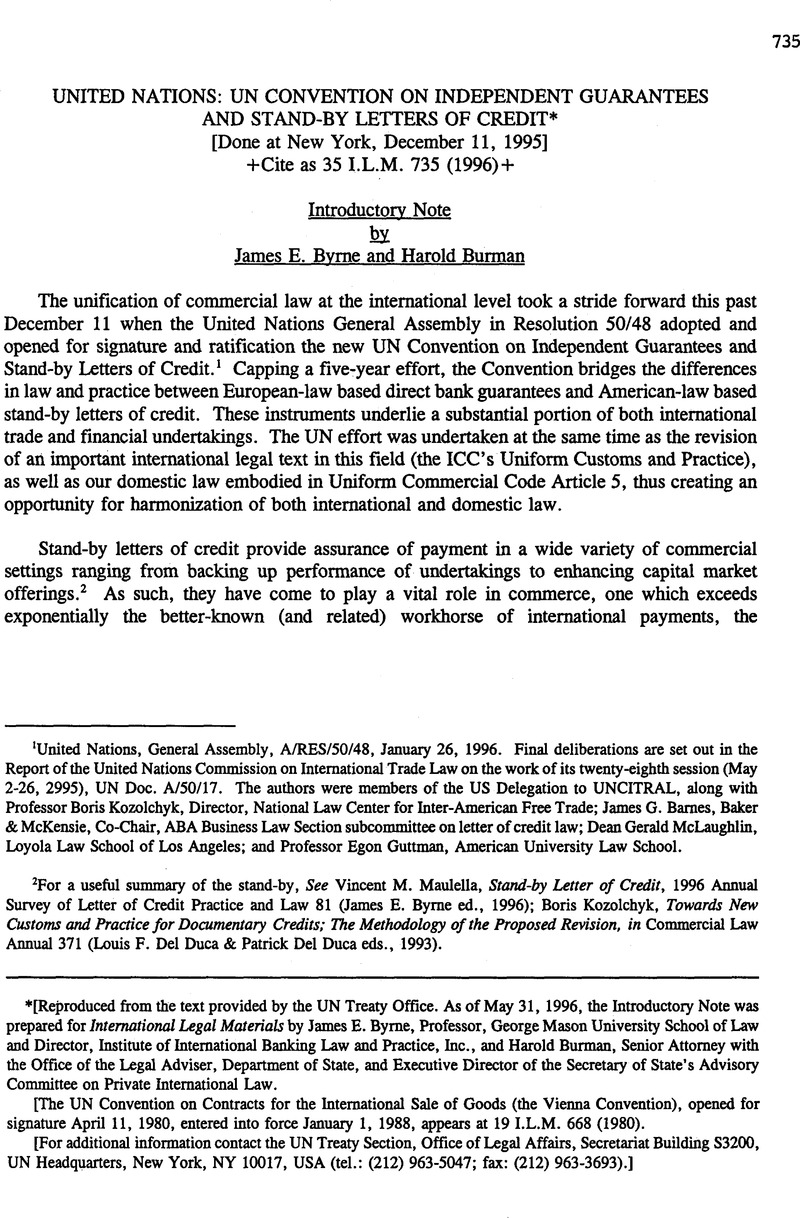Article contents
United Nations: UN Convention on Independent Guarantees and Stand-by Letters of Credit
Published online by Cambridge University Press: 27 February 2017
Abstract

- Type
- Treaties and Agreements
- Information
- Copyright
- Copyright © American Society of International Law 1996
References
* [Reproduced from the text provided by the UN Treaty Office. As of May 31, 1996, the Introductory Note was prepared for International Legal Materials by James E. Byrne, Professor, George Mason University School of Law and Director, Institute of International Banking Law and Practice, Inc., and Harold Burman, Senior Attorney with the Office of the Legal Adviser, Department of State, and Executive Director of the Secretary of State's Advisory Committee on Private International Law.
[The UN Convention on Contracts for the International Sale of Goods (the Vienna Convention), opened for signature April 11, 1980, entered into force January 1, 1988, appears at 19 I.L.M. 668 (1980).
[For additional information contact the UN Treaty Section, Office of Legal Affairs, Secretariat Building S3200, UN Headquarters, New York, NY 10017, USA (tel.: (212) 963-5047; fax: (212) 963-3693).]
1 United Nations, General Assembly, A/RES/50/48, January 26, 1996. Final deliberations are set out in the Report of the United Nations Commission on International Trade Law on the work of its twenty-eighth session (May 2-26, 2995), UN Doc. A/50/17. The authors were members of the US Delegation to UNCITRAL, along with Professor Boris Kozolchyk, Director, National Law Center for Inter-American Free Trade; James G. Barnes, Baker & McKensie, Co-Chair, ABA Business Law Section subcommittee on letter of credit law; Dean Gerald McLaughlin, Loyola Law School of Los Angeles; and Professor Egon Gunman, American University Law School.
2 For a useful summary of the stand-by, See Vincent M. Maulella, Stand-by Letter of Credit, 1996 Annual Survey of Letter of Credit Practice and Law 81 (James E. Byrne ed., 1996); Boris Kozolchyk, Towards New Customs and Practice for Documentary Credits; The Methodology of the Proposed Revision, in Commercial Law Annual 371 (Louis F. Del Duca & Patrick Del Duca eds., 1993).
3 This figure is based on reported figures from U.S. federally insured banks, See L/C Activity at 300 U.S. Commercial Banks: 2nd Quarter 1995, 12 Letter Of Credit Update 2 (February 1996) and conservative estimates based on these figures.
4 As of 1996, the end of the second quarter of 1995, U.S. federally insured banks reported a total of $37,726,974,000.00 outstanding in performance stand-bys and $115,788,410,000.00 outstanding in financial standbys. Id. It is reasonable to assume that the amount of financial stand-bys issued by non-federally insured foreign banks in the U.S. greatly exceeds these amounts, given the recent credit rating history of U.S. banks; however, no statistics are available. 5It was established at a relatively early date in the emergence of stand-bys that they were governed by Article
5 (Letters of Credit) of the Uniform Commercial Code. See, e.g., O'Grady v. First Union Nat'l Bank, 250 S.E.2d 587, 599 (N.C. 1978). The recent revision of U.C.C. Article 5 took the coverage of stand-bys together with commercial credits for granted.
6 In the mid-seventies, concerns were raised regarding the exponential growth in volume out standings which led to Congressional hearings. As a result, regulatory schemes emerged which capped outstanding stand-by obligations to a given customer based on a percentage of a bank's capital. Unsafe and Unsound Banking Practices, 12 C.F.R. §337.2 (1990). In the 1980's, similar concern led to capital adequacy requirements. Minimum Capital Ratios, 12 C.F.R. §3.6 (1990). In a progressive reformulation of its interpretative guidelines, the U.S. Comptroller of the currency recently issued a comprehensive regulatory approach to independent undertakings. See Interpretive Rulings, 61 Fed. Reg. 4849 (Feb. 9, 1996) (to be codified at 12 C.F.R. pt. 7 and 31).
7 Many stand-bys are subject to the Uniform Customs and Practice for Documentary Credits, issued by the Commission on Banking Technique & Practice of the International Chamber of Commerce. The latest revision is ICC Publication No. 500 (1994). In the 1983 revision, ICC Publication No. 400, the UCP somewhat enigmatically recognized that it governed stand-bys “to the extent to which they may be applicable.” Because of the need for greater clarity, and at the request of many countries involved at the negotiations at Uncitral, the Institute of International Banking Law & Practice, the U.S. Council on International Banking, and the National Law Center on Inter American Free Trade have undertaken a project to formulate practice rules for stand-by letters of credit with the support of the U.S. Department of State.
8 See Revised U.C.C. § 5-103(d).
9 See Revised U.C.C. § 5-102(a)(10).
10 See Revised U.C.C. § 5-108(e).
11 UNCITRAL was established in 1967 as a General Assembly body whose mandate includes the progressive harmonization of international commercial law. The United States has been a member since its inception. The Commission has remained throughout a technically-focused and non-politicized body.
12 A review of the Convention's provisions is set out in the Secretariat's Explanatory Note, UN Doc. A/CN.9/431, May 1996.
13 It is not customary for guarantees to be transferred or conveyed. See Articles 9 and 10.
- 1
- Cited by


